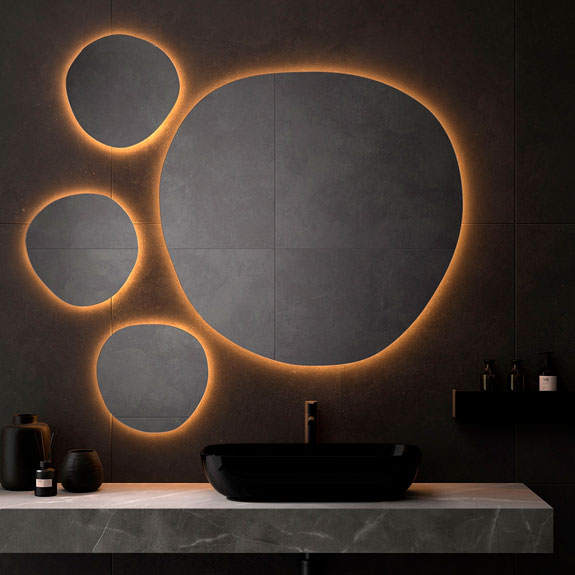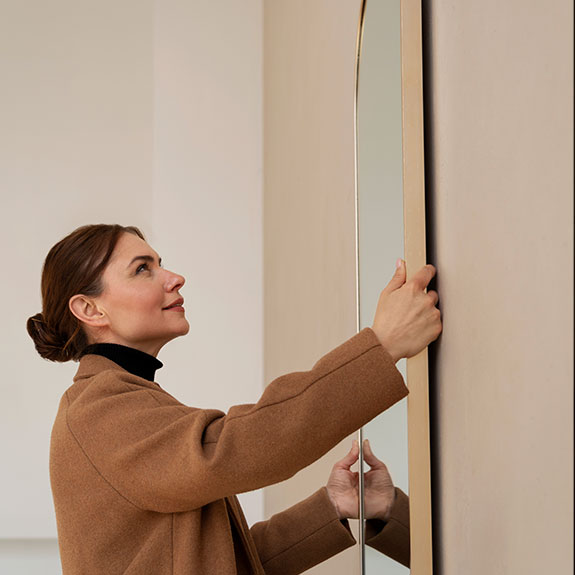Mirrors in interior design have been used for centuries, not only for their functionality, but also for their ability to transform spaces. Whether to visually enlarge a room, increase brightness or simply add a decorative touch, the right integration of mirrors in the home can make a difference in the aesthetics and functionality of any space.
In this article, we will explore how to make the most of mirrors in interior design, analyzing their benefits, types, strategic locations and mistakes to avoid.
Benefits of mirrors in decoration
Visual enlargement of space
One of the main reasons mirrors are so popular in interior design is their ability to make spaces appear larger. Strategically placed, they can create the illusion of greater depth, reflecting walls and visually opening up a room.
Increased brightness
Mirrors are perfect allies to improve the lighting of a room. Placed in front of windows or artificial light sources, they reflect and distribute light evenly, bringing clarity and warmth to any environment.
Versatile decorative element
Beyond their functionality, mirrors can be decorative pieces that add elegance and personality to a room. From classic models with ornate frames to minimalist and contemporary designs, there is a mirror for every decorating style.
Focal points and highlighting of architectural elements
A well-placed mirror can become the focal point of a room, enhancing fireplaces, furniture or even outdoor views by strategically reflecting them.
Types of interior mirrors according to their design
Mirrors come in multiple designs and finishes. Some of the most popular in interior design include:
- Modern mirrors: Clean-lined, minimalist designs with metal or frameless frames.
- Classic mirrors: Models with ornamented frames in gold or silver tones.
- Vintage mirrors: Inspired by past decades, with aged or carved wooden frames.
- Industrial mirrors: Designs with metallic structure in black or rusty tones, ideal for loft type decorations.
- Geometric mirrors: Unusual shapes such as hexagons, overlapping circles or asymmetrical compositions.
Mirrors for interior decoration according to their functionality
Depending on their use, mirrors can be classified as follows:
- Decorative mirrors: Designed primarily to beautify a space without a direct practical function.
- Full-length mirrors: Ideal for bedrooms and dressing rooms, allowing you to see yourself completely.
- LED Illuminated Mirrors: Perfect for bathrooms and powder rooms, providing even light for grooming.
- Multifunctional mirrors: Models that incorporate storage or include technology, such as smart mirrors with connectivity.

How to choose the right size and shape of the mirror
The key to integrating a mirror harmoniously into a space lies in its proportion to the room and furniture. Some recommendations include:
- A large mirror on a small wall can make the room look more spacious.
- Small, grouped mirrors work well in hallways or entryways to generate dynamism.
- A rectangular mirror over a sofa or fireplace can become a focal point in the living room.
- Round mirrors soften the lines of spaces and provide visual fluidity.
Strategic use of interior mirrors in each room
Salon
Placing a large mirror on the main wall or on a piece of furniture helps to give amplitude and elegance. You can also create a composition with several small mirrors in geometric shapes for a more dynamic decoration.
Dining room
A mirror in the dining room can reflect the light from a pendant light fixture, adding warmth and depth. It is important to avoid placing the mirror reflecting cluttered areas or the kitchen.
Bedroom
Mirrors can be installed in closets, at the head of the bed or on a side wall. A full-length mirror is ideal for dressing, while a small one on the bedside table can add a decorative touch.
Bath
In the bathroom, mirrors with LED lighting are a modern and functional option. Double mirrors can also be placed in shared bathrooms or a vertical mirror if space is limited. In ParatuReforma you can choose from a wide range of bathroom mirrors.

Hallways and foyers
A mirror in the foyer brings brightness and allows you to make a last check before leaving home. In long and narrow corridors, placing a mirror at the end can give the sensation of greater amplitude.
Integration of mirrors in small spaces
To maximize the perception of spaciousness in small rooms, it is recommended:
- Use a large mirror on a full wall.
- Place a full-length mirror on a cabinet door.
- Avoid mirrors with overloaded frames that can overload the space.
How to improve lighting with mirrors
To better reflect the light, the mirrors should be positioned:
- In front of windows to distribute natural light.
- Together with floor lamps or wall sconces.
- On sloping roofs or areas with little natural light to increase luminosity.
Common mistakes when decorating with mirrors and how to avoid them
- Reflect unwanted elements: Never place a mirror in front of a cluttered or unaesthetic area.
- Visual saturation: Avoid overloading a room with too many mirrors, as this can be chaotic.
- Incorrect placement: Do not place a mirror directly in front of a door, as it can generate a visual clash effect.

Maintenance and cleaning of mirrors
To keep mirrors in good condition:
- Clean regularly with a soft cloth and glass cleaner.
- Avoid using abrasive products on the frames.
- Check the fasteners to ensure that they are securely fastened to the wall.
Mirrors are key tools in interior design that can completely transform a space. Their correct integration not only improves the aesthetics of an environment, but also provides spaciousness, luminosity and dynamism.
Where is it best to place a mirror in a living room?
In front of a natural light source or on a sofa to provide spaciousness and elegance.
What type of mirror is ideal for a small bathroom?
One with integrated LED lighting and no frame to maximize space.
How to prevent a mirror from reflecting something unwanted?
Before installing it, check which elements it will reflect from different angles.









